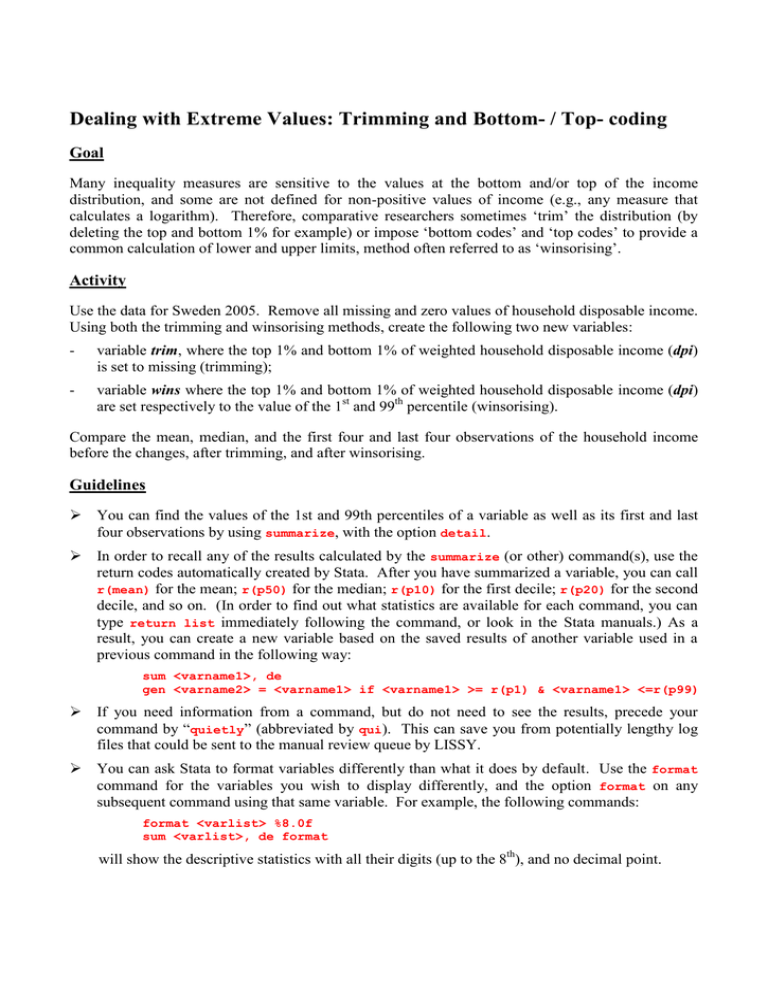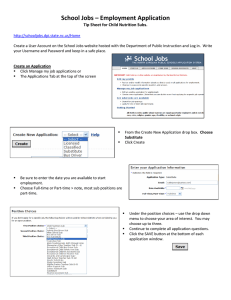Dealing with Extreme Values: Trimming and Bottom- / Top
advertisement

Dealing with Extreme Values: Trimming and Bottom- / Top- coding Goal Many inequality measures are sensitive to the values at the bottom and/or top of the income distribution, and some are not defined for non-positive values of income (e.g., any measure that calculates a logarithm). Therefore, comparative researchers sometimes „trim‟ the distribution (by deleting the top and bottom 1% for example) or impose „bottom codes‟ and „top codes‟ to provide a common calculation of lower and upper limits, method often referred to as „winsorising‟. Activity Use the data for Sweden 2005. Remove all missing and zero values of household disposable income. Using both the trimming and winsorising methods, create the following two new variables: - variable trim, where the top 1% and bottom 1% of weighted household disposable income (dpi) is set to missing (trimming); - variable wins where the top 1% and bottom 1% of weighted household disposable income (dpi) are set respectively to the value of the 1st and 99th percentile (winsorising). Compare the mean, median, and the first four and last four observations of the household income before the changes, after trimming, and after winsorising. Guidelines You can find the values of the 1st and 99th percentiles of a variable as well as its first and last four observations by using summarize, with the option detail. In order to recall any of the results calculated by the summarize (or other) command(s), use the return codes automatically created by Stata. After you have summarized a variable, you can call r(mean) for the mean; r(p50) for the median; r(p10) for the first decile; r(p20) for the second decile, and so on. (In order to find out what statistics are available for each command, you can type return list immediately following the command, or look in the Stata manuals.) As a result, you can create a new variable based on the saved results of another variable used in a previous command in the following way: sum <varname1>, de gen <varname2> = <varname1> if <varname1> >= r(p1) & <varname1> <=r(p99) If you need information from a command, but do not need to see the results, precede your command by “quietly” (abbreviated by qui). This can save you from potentially lengthy log files that could be sent to the manual review queue by LISSY. You can ask Stata to format variables differently than what it does by default. Use the format command for the variables you wish to display differently, and the option format on any subsequent command using that same variable. For example, the following commands: format <varlist> %8.0f sum <varlist>, de format will show the descriptive statistics with all their digits (up to the 8th), and no decimal point. LAB SESSION LWS BASIC Program di "** INCOME DISTRIBUTION II – Exercise 12 **" use hweight dpi if (!mi(dpi) & !(dpi==0)) using $se05h, clear quietly sum dpi [w=hweight], de gen trim=dpi if dpi>=r(p1) & dpi<=r(p99) gen wins=dpi replace wins=r(p1) if dpi<=r(p1) replace wins=r(p99) if dpi>=r(p99) format dpi trim wins %8.0f sum dpi trim wins [w=hweight], de format LIS Summer Workshop 2010 LAB SESSION LWS BASIC LIS Summer Workshop 2010 Results Original values After trimming After winsorising 16,268 15,918 16,268 Average income 269,551 262,484 265,713 Median income 223,861 223,861 223,861 -1,053,732 43,066 43,066 2 smallest: -813,940 43,487 43,066 3rd smallest: -270,365 43,644 43,066 4th smallest: -239,543 43,671 43,066 6,542,836 803,085 806,076 6,746,146 803,952 806,076 7,609,412 804,307 806,076 1,072,029,135 806,076 806,076 Number of valid observations Income level of the first four observations (smallest incomes) Income level of the last four observations Smallest: nd 4th largest: rd 3 largest: nd (highest incomes) 2 largest: Largest:


